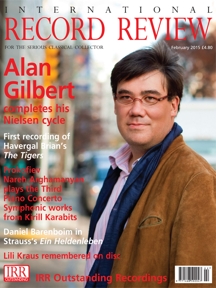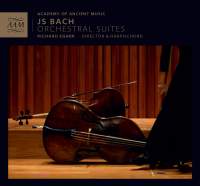Texte paru dans: / Appeared in: |
|
|
Outil de traduction (Très approximatif) |
|
|
Reviewer: Nigel
Simeone In his 'Director's Note' in the booklet, Richard Egarr explains an important feature of this splendid new set of the four Orchestral Suites: 'Using one player per part creates a wonderful chamber‑music feel and allows the flexibility that is essential in Bach's music.' The results are a constant delight, and by using lower Baroque pitch (and sensitive musicians) there are no balance problems between trumpets and strings. What emerges with marvellous clarity is the inventiveness and colour of Bach's instrumentation.
In the First Suite, the contrasting sonorities of strings and oboes and bassoon come across not just with transparency but with a presence and relish that is usually found only in chamber music playing. There's nothing odd about playing Bach's suites with solo instruments ‑ indeed there's plenty of evidence to suggest that one instrument to a part was at least one of the options the composer himself had in mind when he wrote these pieces ‑ and it works exceptionally well when the players are as experienced and imaginative as the members of the Academy of Ancient Music on this set. The Second Suite is animated from the start by intelligent and subtle phrasing, and the balance between Rachel Brown's flute, the strings and harpsichord seems completely natural ‑ as it seldom can be in performances with larger forces. But just as important is the quality of elasticity and expressiveness that playing music with such intimate forces allows.
Another point Egarr makes in his introductory note is that he wanted te, get away from the quest for ever‑quicker speeds in these works. His approach has many advantages: first, the dance movements emerge with their distinctive character while losing nothing in vitality. And second, in a movement such as the 'Badinerie' at the end of the Second Suite, the music can be shaped and energized without galloping for the double bar ‑ and there's space for some delicious ornamentation too, without any loss of momentum‑ proving the point that 'fast' does not necessarily create more rhythmic life or excitement.
Egarr and the AAM are no slowcoaches, but their aim throughout is to emphasize and delight in the dance elements of these works. So the concluding 'Gigue' of the Third Suite has a lift and physicality that I found really inspiring, especially as the changes in orchestral colour between the sections with and without trumpets are so thrillingly realized with the forces used. In this movement (and indeed in the 'Badinerie'), the approach of Egarr and the AAM is similar to the one‑to‑a‑part recording by La Petite Bande and Sigiswald Kuijken. Both are extremely effective, not least because they avoid rushing for the sake of it ‑ there's bags of animation, but nothing is garbled. By a small margin, I prefer de greater clarity and precision of the AAM's playing, and this is helped by a recording which is exceptionally lucid and natural‑sounding, an ideal complement to the performances.
The main booklet essay is an immensely stimulating and fascinating account of the suites by the great Bach scholar Christoph Wolff. There are several very good period instrument recordings of these pieces available, so competition is stiff ‑ but Egarr and the AAM have found a thoroughly individual approach that is never quixotic and always inventive. This set is a joy from start to finish and it's an exhilarating new front‑runner in a crowded field.
|
|
|
|
|
|
Cliquez l'un ou l'autre
bouton pour découvrir bien d'autres critiques de CD |
|




